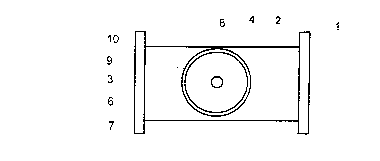Une partie des informations de ce site Web a été fournie par des sources externes. Le gouvernement du Canada n'assume aucune responsabilité concernant la précision, l'actualité ou la fiabilité des informations fournies par les sources externes. Les utilisateurs qui désirent employer cette information devraient consulter directement la source des informations. Le contenu fourni par les sources externes n'est pas assujetti aux exigences sur les langues officielles, la protection des renseignements personnels et l'accessibilité.
L'apparition de différences dans le texte et l'image des Revendications et de l'Abrégé dépend du moment auquel le document est publié. Les textes des Revendications et de l'Abrégé sont affichés :
| (12) Demande de brevet: | (11) CA 2261583 |
|---|---|
| (54) Titre français: | DISPOSITIF POUR ACCORDER UN SYSTEME A HYPERFREQUENCE |
| (54) Titre anglais: | DEVICE FOR TUNING A MICROWAVE SYSTEM |
| Statut: | Réputée abandonnée et au-delà du délai pour le rétablissement - en attente de la réponse à l’avis de communication rejetée |
| (51) Classification internationale des brevets (CIB): |
|
|---|---|
| (72) Inventeurs : |
|
| (73) Titulaires : |
|
| (71) Demandeurs : |
|
| (74) Agent: | SMART & BIGGAR LP |
| (74) Co-agent: | |
| (45) Délivré: | |
| (86) Date de dépôt PCT: | 1997-07-07 |
| (87) Mise à la disponibilité du public: | 1998-02-05 |
| Licence disponible: | S.O. |
| Cédé au domaine public: | S.O. |
| (25) Langue des documents déposés: | Anglais |
| Traité de coopération en matière de brevets (PCT): | Oui |
|---|---|
| (86) Numéro de la demande PCT: | PCT/DE1997/001463 |
| (87) Numéro de publication internationale PCT: | WO 1998005086 |
| (85) Entrée nationale: | 1999-01-20 |
| (30) Données de priorité de la demande: | |||||||||
|---|---|---|---|---|---|---|---|---|---|
|
L'invention concerne un dispositif d'accord, permettant, avec un mécanisme peu complexe, de modifier rapidement l'accord des fréquences d'un système à hyperfréquence. Ce dispositif comprend un ou plusieurs éléments d'accord (2, 3) faisant saillie à l'intérieur d'un guide d'ondes (1), lesdits éléments étant montés de façon à pouvoir tourner autour d'un axe (4) perpendiculaire à l'axe longitudinal du guide d'ondes.
A tuning device which allows the fast periodical frequency tuning of a
microwave system with simple mechanical means consists of one or several
tuning elements (2, 3) which project into a wave guide (1) and are mounted to
rotate around an axis (4) perpendicular to the longitudinal axis of the wave
guide.
Note : Les revendications sont présentées dans la langue officielle dans laquelle elles ont été soumises.
Note : Les descriptions sont présentées dans la langue officielle dans laquelle elles ont été soumises.

2024-08-01 : Dans le cadre de la transition vers les Brevets de nouvelle génération (BNG), la base de données sur les brevets canadiens (BDBC) contient désormais un Historique d'événement plus détaillé, qui reproduit le Journal des événements de notre nouvelle solution interne.
Veuillez noter que les événements débutant par « Inactive : » se réfèrent à des événements qui ne sont plus utilisés dans notre nouvelle solution interne.
Pour une meilleure compréhension de l'état de la demande ou brevet qui figure sur cette page, la rubrique Mise en garde , et les descriptions de Brevet , Historique d'événement , Taxes périodiques et Historique des paiements devraient être consultées.
| Description | Date |
|---|---|
| Inactive : CIB de MCD | 2006-03-12 |
| Demande non rétablie avant l'échéance | 2001-04-24 |
| Inactive : Morte - Aucune rép. à lettre officielle | 2001-04-24 |
| Réputée abandonnée - omission de répondre à un avis sur les taxes pour le maintien en état | 2000-07-07 |
| Inactive : Renseign. sur l'état - Complets dès date d'ent. journ. | 2000-06-02 |
| Inactive : Abandon. - Aucune rép. à lettre officielle | 2000-04-25 |
| Symbole de classement modifié | 1999-03-29 |
| Inactive : CIB attribuée | 1999-03-29 |
| Inactive : CIB en 1re position | 1999-03-29 |
| Inactive : Lettre de courtoisie - Preuve | 1999-03-23 |
| Inactive : Notice - Entrée phase nat. - Pas de RE | 1999-03-16 |
| Demande reçue - PCT | 1999-03-12 |
| Modification reçue - modification volontaire | 1999-02-11 |
| Demande publiée (accessible au public) | 1998-02-05 |
| Date d'abandonnement | Raison | Date de rétablissement |
|---|---|---|
| 2000-07-07 |
Le dernier paiement a été reçu le 1999-04-22
Avis : Si le paiement en totalité n'a pas été reçu au plus tard à la date indiquée, une taxe supplémentaire peut être imposée, soit une des taxes suivantes :
Veuillez vous référer à la page web des taxes sur les brevets de l'OPIC pour voir tous les montants actuels des taxes.
| Type de taxes | Anniversaire | Échéance | Date payée |
|---|---|---|---|
| Taxe nationale de base - petite | 1999-01-20 | ||
| TM (demande, 2e anniv.) - petite | 02 | 1999-07-07 | 1999-04-22 |
Les titulaires actuels et antérieures au dossier sont affichés en ordre alphabétique.
| Titulaires actuels au dossier |
|---|
| AFT ADVANCED FERRITE TECHNOLOGY GMBH |
| Titulaires antérieures au dossier |
|---|
| ERICH PIVIT |
| HANS-MICHAEL GRELL |
| WOLFGANG ARNOLD |